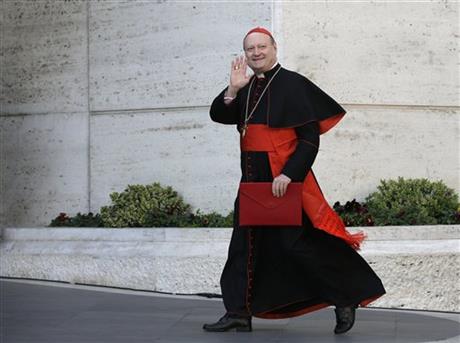
By NICOLE WINFIELD
A new Vatican outreach initiative to listen to women hit a sour note before it even got off the ground: The sexy blonde on its Internet promo video came under such ridicule that it was quickly taken down.
But the program is going ahead, and an inaugural meeting this week will study women’s issues in ways that are utterly new for the Holy See.
No, there is no talk of ordaining women priests.
But the working paper for the Pontifical Council of Culture’s plenary assembly on “Women’s Cultures: Equality and Difference” speaks about opening the church’s doors to women so they can offer their skills “in full collaboration and integration” with men.
It denounces plastic surgery as a form of “aggression” against the female body “like a burqa made of flesh.” And it acknowledges that the church has for centuries offered women “ideological and ancestral left-overs.”
This is dangerous territory for the all-male Catholic Church hierarchy, as even Pope Francis has faced criticism for being a bit tone deaf as far as women are concerned.
The pontiff, a master of communication, has sincerely praised the “feminine genius.” But he has also elicited cringes, such as when he recently welcomed female members of the church’s most prestigious theological commission as “strawberries on the cake.” And when asked if a woman might someday head a Vatican office, he joked that “pastors often wind up under the authority of their housekeeper!”
Few people doubt the seriousness of Francis’ pledge to appoint women to key Vatican decision-making jobs once his bureaucratic reform is complete. Nor do they question his sincerity when he says: “Women can ask questions that we men just don’t get.”
But, as Vatican commentator David Gibson recently pointed out, Francis can also sound an awful lot like the 78-year-old Argentine churchman that he is – “using analogies that sound alternately condescending and impolitic, even if well-intentioned.”
The Vatican has made progress in recent years, appointing laywomen to some Vatican offices and giving women’s issues as a whole more ink with the monthly women’s insert of the Vatican newspaper, L’Osservatore Romano.
But many would argue that much remains to be done when the recently ousted Vatican high court judge, Cardinal Raymond Burke, complains that the church has been “assaulted” by radical feminism and that the shortage of priests is due to an overly “feminized” church.
The latest initiative comes courtesy of Cardinal Gianfranco Ravasi, an academic who quotes Nietzsche and Amy Winehouse with equal ease and has no fear of courting controversy as he raises the Vatican profile in sport, art and even atheist circles at the helm of the Vatican’s culture ministry.
Ravasi’s first major foray into women’s issues, however, was a flop – at least in the English-speaking world.
Just before Christmas, his office launched the #lifeofwomen crowd-sourcing initiative to promote the Feb. 4-7 plenary meeting and invite women around the globe to send in a 60-second video of their lives for possible inclusion in a montage to be screened at the “big meeting of cardinals and bishops” next week.
In the video, Italian actress Nancy Brilli – buxom albeit in a modest blue top – earnestly asked her viewers how often they ask themselves “Who are you? What do you do? What do you think about yourself as a woman?”
The criticism was swift and harsh.
“What were they thinking at the Vatican?” wrote Phyllis Zagano of Hofstra University in the liberal National Catholic Reporter. “Aside from the obvious – sexy sell has long gone by the boards in developed nations and is totally unacceptable in predominantly Muslim countries – the fact of the matter is that highlighting a stereotypical spokeswoman is not the way to ask for women’s input.”
Critics noted that the women the Vatican might most want to hear from – those suffering from poverty, violence or war – might not have a smart phone at hand to send in a clip. Others noted that the two-week deadline – at the height of the Christmas holidays – worked against any widespread response.
The English version of Brilli’s promo was summarily yanked, though the Italian remains on the ministry’s website.
In the end, some 250 videos were sent in. A good number came from activists advocating for women’s ordination.
Consuela Corradi, a sociologist at Rome’s Catholic Lumsa university, was one of 15 women who advised Ravasi on the initiative. She complained that criticism of the video was unfair.
“If we had chosen an ugly woman, would that have changed the message? I don’t think so,” she said. She said the women consultants were entirely responsible for penning the working document, with no interference from the ministry, though she said their document was trimmed for length.
It remains unclear, however, what will come of it. Often such working drafts become the basis for a final document that is adopted by the full membership of a Vatican office at the end of a plenary meeting. Ravasi, though, hasn’t said what he’ll do with it.
Helen Alvare, a law professor at George Mason University and a consultant at the Vatican’s laity office, said the language in the draft paper was remarkable given that it calls for “collaboration and integration” with men within the church. She said that mirrors findings from leading business consultancies that companies do better when men and women collaborate at every level.
“That statement is the strongest endorsement I have seen in a church document for what we sometimes call complementarity within the church,” she said in a phone interview.



